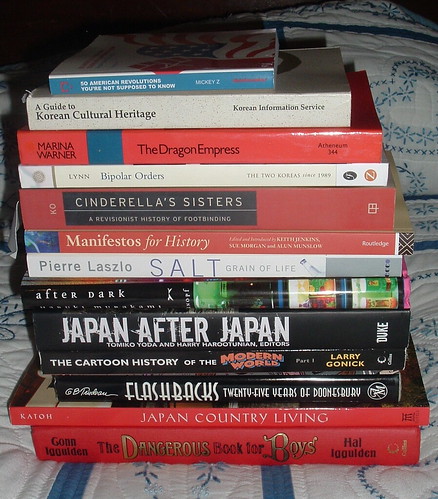It was a very busy conference for me, but my meetings didn’t leave me a lot of time for panels.1 None, in fact, except for our own, which was great fun. I did get to do some social stuff, including the Cliopatria/IHE dinner, a visit with the Progressive Historian himself and an evening with a college friend that ended up at a used bookstore (see below).
I did think our panel was quite fun, though a bit limited by the absence of Nathanael Robinson (and his paper). That said, though, I think Alan Baumler and Rebecca Goetz did an excellent job squaring the circle of our presentations, a job that would have been complicated by another thesis. One of the members of the audience was a British grad student who’s doing microhistory in the same regions I studied in Yamaguchi: it was a pleasant, but shocking, experience to realize that I’m not going to be the only person who knows something about this.
My own paper is an outgrowth of thinking about ways to connect the history of Japanese emigration with contemporary Japanese immigration issues. The return migration of Nikkei from Brazil, the Philipines, North America, etc., is a striking case: Japan permits easy remigration of these groups because they are expected to be culturally assimilable in a way that Chinese, Korean or Philippine immigrants wouldn’t be, but the assimilation which has taken place over three or four generations has made that considerably more difficult. Why, then, didn’t Japanese authorities (or the Japanese people in general) realize that assimilation would create culturally distinct Nikkei? My theory is that pre-’45 nationalism obscured the normal patterns of assimilation which take place in multi-generational immigrant communities: certainly, out-migration to Hawai’i and the Philippines was thought of like colonial frontier settlement more than as the transfer of population to a new host culture. Histories of emigration and studies of Nikkei communities by Japanese scholars continued to obscure assimilation by focusing on the way in which traditional values and recreated traditional institutions bolstered the overseas community, taking their successes as evidence of innate Japanese qualities — perseverence, education2, cohesion. This is particularly stark when compared with English language histories of immigration, which emphasize assimilation as the very foundation of success in the new host culture, and emphasize efforts at modernization and entrepreneurship.
Manan Ahmed’s paper was much more interesting, a historiography of the tension between conquerers as national heroes and heroic resisters as local icons. The local counternarrative of resistance got very elaborate, as entertaining stories of weaker figures wrecking vengeance on powerful ones often are. Ultimately, as he described it, the heroic invader — heroic from the standpoint of constructing a unified national narrative, anyway — is dehistoricized and turned into an inoffensive (and uninspiring, I’d guess) “unifier” while local resistance is effectively erased from the national narrative.3 In other words, and I don’t remember who said it this way, but someone did, the life is drained out of the biography until the hero becomes “nice.”
I do remember Alan Baumler’s comments drawing the papers together by highlighting their biographical and genealogical aspects, the way in which pre-national figures can be integrated into national self-narratives as ancestors and the way in which shared ancestry can bridge other modern/national divides. The idea that values are inherited through blood is a powerful common error with which we regularly contend. I was just lecturing this week on nationalism, and the way in which it is based on an historical fiction which obscures margins, minorities and migration.4 There was some discussion — initiated by Rebecca, if memory serves — about the way in which many nations cleanse their histories by a similar sort of biographical emasculation or justify invasions and other atrocities by a sort of victors’ hagiography.5
The traditional collection of new books:6 I was struck by how much of my book exhibit time is spent thinking about potential course materials, and how much quicker I was moving through the hall when that wasn’t my primary consideration.

In spite of which, I’m in the running for latest conference blogging ↩
There’s a whole research program yet to be undertaken with regard to educational values. The standing assumption, based on the high educational achievements of Nisei, is that there was something inherent in traditional Japanese culture which valued education, which is patently untrue for the rural laborers who make up a large portion of the immigrant population. The successor thesis — that the Meiji emphasis on education and “self-help” was the key factor — assumes a rapid transmission of these ideas from city to country which is a bit hard to accept. The basic question of literacy rates among immigrants versus their sending communities isn’t really clear yet, and a fair examination of the other questions really hasn’t been done. ↩
note some of the similarities to Hiraku Shimoda’s argument ↩
I didn’t use the alliteration in class, but I’m going to have to remember it for next time ↩
I was reminded, though I didn’t get a chance to mention it, of the Enola Gay controversy ↩
Books from the Exhibit Hall, Second Story Books in Dupont Circle, and some Christmas gifts. I finished the Doonesbury, of course. I’m currently reading Cinderella’s Sisters and enjoying it immensely. The Dangerous Book for Boys has some interesting historical bits in it — biographies, great battles. ↩